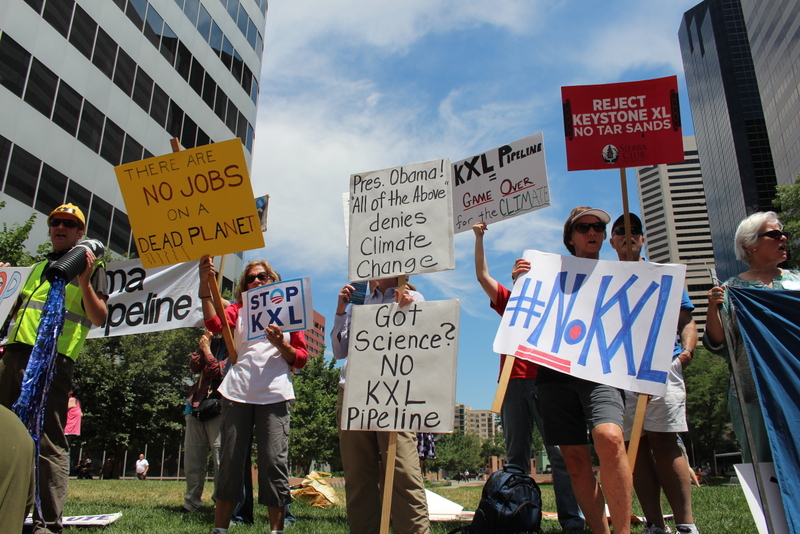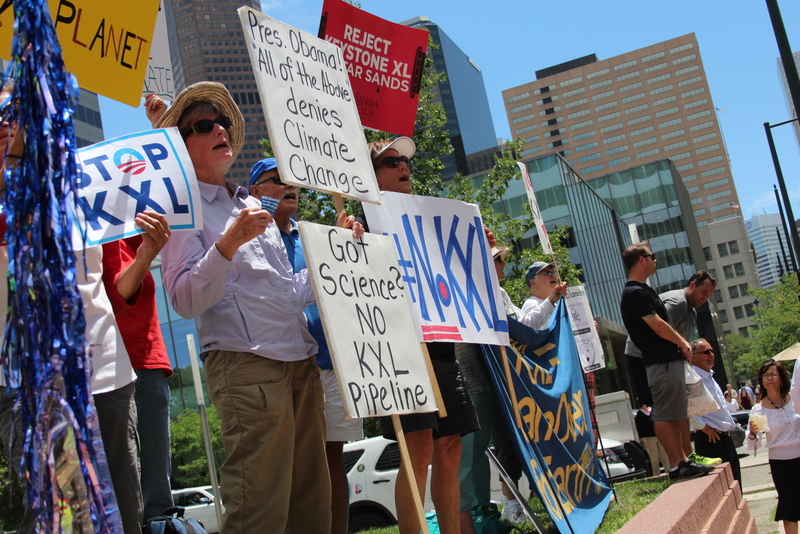DENVER-Following President Obama from Cheesman Park today was a crowd of about 50 Coloradans who were holding signs that read “No KXL Pipeline!”
The group lined the path of his motorcade and then later lined the area in front of the Westin Hotel where Obama held a fundraiser for Colorado Senator Mark Udall. Protesters also carried a makeshift oil pipeline as a prop.
In Cheesman Park downtown, he was met by those who expressed concern for the Palestinian people and also by those who want him to reject construction of the Keystone XL tar sands pipeline. If approved, the pipeline will carry 800,000 barrels a day of tar sands crude oil from Alberta, Canada to the gulf coast for refining and transport out of the country.
The President has delayed approving the pipeline in the recent past citing the need for a more in-depth analysis, but Senator Udall last month cast a “no” vote after the head of the Senate Energy Committee Mary Landrieu (D-LA) forced a vote on the pipeline on June 18, 2014 through a bill she co-sponsored with Senator John Hoeven (R-ND). Still the Senate Energy and Natural Resources Committee approved that bill-passing on a 12-10 vote- which would have meant approval of the Keystone XL pipeline. Following a virtual party line vote where Landrieu and Sen. Joe Manchin (D-W.Va.) were two Democrats voting for approval, the bill isn’t expected to meet a full Senate vote in the near future.
A spokesman for Udall on Thursday released a statement from the senator:
“The Keystone XL Pipeline has been needlessly politicized. Coloradans expect better from their leaders. If this pipeline were being routed through Colorado, my constituents would want to know that science — and not politics — determined the way forward. I am frustrated the Obama Administration has taken more than five years to get to this point, but the technical review process needs to run its course. That’s why I continue to vote against all amendments — Democratic or Republican — that would inject more politics into the pipeline review process.”
Since the measure is not expected to make it to a full Senate vote before the elections in November the Senator’s vote is considered to be merely a “show” vote. Still protesters at yesterday’s event were happy with the action taken by the senator such as Ryan Denham, a team leader with the local chapter of the international environmental group 350.org, “We’d like to see as many members of Congress oppose this pipeline as possible. We had a pretty good crowd out there. We’ve been chanting. A lot of the attendees saw us, but actually at the president’s arrival this morning, he did see us with our Keystone XL signs. So I would say that that was our goal today. It was to have the president see concerned Coloradans that don’t want a dangerous pipeline through the country. These pipelines leak.”
The corporation Transcanada that wants to build the pipeline experienced spills 14 times in the U.S. in its first year of operation and Enbridge, another pipeline operator fought a spill of more than one million gallons in the Kalamazoo River in 2010. The Nation Report talked to Kalamazoo residents last month who said that the clean-up still is not complete there. They reported that dredging continues in the Kalamazoo river following a cover-up by Enbridge that they say used the same chemical that was used in the BP Gulf Oil spill to sink the oil rather than cleaning it up.
Denham cited concerns about spills as well, “We’ve had dangerous tar sands spills in Arkansas and Michigan so we can’t take a chance of putting this pipeline through the northern half of the United States. All we can do is keep the pressure up and keep informing citizens about the dangers of tar sands oil and how bad it’s going to be for climate change and potential for spills and the environment and we’ll just continue to get the word out and keep the pressure up.”
In March, The Nation Report reported from South Dakota where First Nations of the Pine Ridge Reservation are organizing against the pipeline and also last year where similar organizing took place in the Cheyenne River reservation of South Dakota. In February of 2013, hundreds met with the representatives from the State Department to express their opposition including members of the Cowboys and Indians Alliance (CIA).
Sandy Toland of Denver is also with 350.org and was met by passersby who challenged the group’s protest, “We were at Cheesman park and we knew we probably wouldn’t see Obama. We just wanted to get media attention because all the TV stations were there and newspapers so we did get an interview over there. [We] just [wanted to] get the word out that way. And here we’re just trying to do the same thing-media attention and maybe Obama might see us standing here when he comes out of the hotel. We do get a response from the people standing around here. People are against us. People are for us.”
Supporters of the pipeline say that the pipeline is needed for the economy, that the jobs are needed, and that the pipeline is needed for the US to become energy independent. Opponents say though that jobs from the pipeline would only last about a year and that after the pipeline is finished, that only a handful of jobs would carry out maintenance of the pipeline. According to statements made by 350.org, “Contrary to claims made by supporters of the pipeline, the pipeline could end as many jobs as it creates with toxic spills in farmland or water resources. Only 10% of the created jobs would be filled by local people living in communities along the route.”
Opponents point out that energy independence would not be affected by the pipeline since the crude oil would be sold to the highest bidder on the open market. Environmentalists warn of future spills based on past history and say tar sands oil is especially “dirty” and will contribute to global warming when it is burned. They say that the especially corrosive nature of tar sands along with the extreme temperatures that are necessary for its transport, lead to strain of component parts to the pipeline that has been found responsible for spills.
First Nations people including along the Sandhills have said that treaties have been broken on land where the pipeline is proposed to cross while threatening their water supply as well as the supply to the entire Midwest and Western Regions that are supplied by the Ogallala Aquifer. The pipeline route would cross more than 1,000 water bodies across 3 states-Montana, South Dakota, and Nebraska-covering 875 miles.
Sandy Toland said of grassroots activism among opponents to the pipeline, “We’re just citizens. We don’t have the money to put countless commercials on TV and radio and the newspaper. So this is a way we can get the word out free if the media covers this. And just to make Obama aware that we’re still wanting him to stop the pipeline.”
Meanwhile protesters yelled to Obama from the street, “Don’t wait until after the election. We want a decision now. Stop the keystone pipeline. It’s up to you.” And “Transcanada you shall not pass. Transcanada, you will not last.”
The Obama administration in April said it was putting off its decision on whether to approve the pipeline indefinitely.
Refufia Gaintan/The Nation Report





